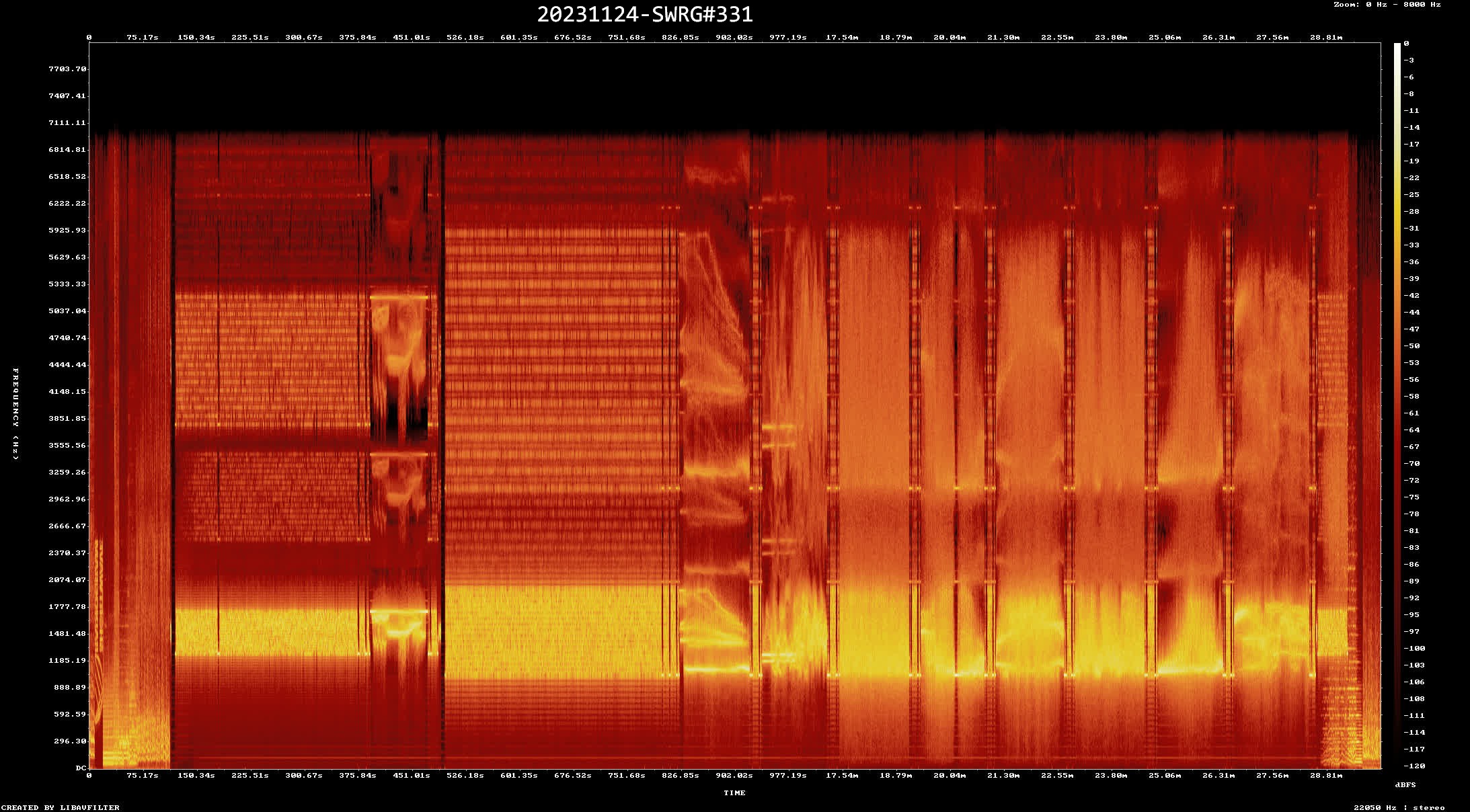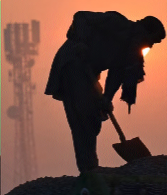
http://www.rhci-online.net/radiogram/radiogram.htm
https://github.com/GyanD/codexffmpeg/releases/tag/2023-03-05-git-912ac82a3c
set MyFiles=*.flac *.fla *.wav *.aif *.mp4 *.mp3 *.mp2 *.aac *.ogg
*.m4a

RSID: <<2023-11-24T00:31Z
MFSK-32 @
9265000+1500>>
Welcome to program 331 of Shortwave Radiogram.
I'm Kim Andrew Elliott in Arlington, Virginia USA.
Here is the lineup for today's program, in MFSK modes as noted:
1:45 MFSK32: Program preview (now)
2:54 MFSK32: Device keeps defunct satellites from
tumbling*
8:00 MFSK64: First commercial-scale ocean thermal
energy*
13:14 MFSK64: This week's images*
28:26 MFSK32: Closing announcements
* with image(s)
Please send reception reports to
radiogram@verizon.net
And visit http://swradiogram.net
We're on X/Twitter now: @SWRadiogram
From New Atlas:
Tiny Airbus device keeps defunct satellites from tumbling
By David Szondy
November 16, 2023
To help combat the growing problem of space debris, a CubeSat
launched by EnduroSat on November 11, 2023 called Exo-0 includes
a 100-g (3.5-oz) device developed by Airbus that uses the Earth's
magnetic field to prevent dead satellites from tumbling.
According to the US Space Surveillance Network, there are over
25,000 artificial objects orbiting the Earth. Considering the
vast volume surrounding the near-space region of Earth, this is a
very tiny number, but most satellites are crowded into a few
highly desirable orbits. It's a bit like air and sea lanes. You
can travel over most of the Earth's surface and rarely see a ship
or plane, but along the busy routes they're as crowded as a
motorway.
When two satellites collide, the result is a cloud of shrapnel
that greatly increases the chances of more collisions and more
damage, referred to as the Kessler syndrome. Since thousands more
satellite launches are planned over the next few years, this
makes managing space debris a very high priority.
One way to do this is to make sure defunct satellites remain
steady because a tumbling satellite is harder for a salvage
spacecraft to dock with, and it makes the satellite interact with
the tenuous atmosphere unpredictably, resulting in an unstable
orbit.
The patented Airbus Detumbler is a simple device that bolts to a
satellite and acts as a stabilizing system that requires no
external power or propellants. It is simply a housing containing
a central rotor wheel and magnets that interact with the Earth's
magnetic field.
According to Airbus, under normal circumstances the rotor acts
like a compass and orients the dead spacecraft to follow the
magnetic field. If the spacecraft starts to tumble, the rotor
movement generates eddy currents that act like a friction torque.
This dampens the motion and stabilizes the satellite.
The Detumbler is scheduled to be tested in orbit early next year.
Source: Airbus
https://newatlas.com/space/tiny-airbus-device-keeps-defunct-satellites-from-tumbling/
Image: Airbus Detumbler reference
design ...
Sending Pic:171x157C;

Shortwave Radiogram now changes to MFSK64 ...
RSID: <<2023-11-24T00:38Z
MFSK-64 @
9265000+1500>>
This is Shortwave Radiogram in MFSK64
Please send your reception report to radiogram@verizon.net
From New Atlas:
First commercial-scale ocean thermal energy generator slated for
2025
By Loz Blain
November 14, 2023
In an average day, tropical oceans absorb about 278
petawatt-hours of solar energy. Harvesting just 1/4000th of that
energy would supply the entire world's daily electricity – and
ocean thermal energy conversion provides a possible method.
Harvesting energy from the temperature differential between the
warm surface and the cold deep ocean is certainly not a new idea
– indeed, it was first trialed 142 years ago in 1881, and a
22-kilowatt OTEC plant was built in Cuba in 1930.
The basic idea is this: you go to an area with a consistently
large temperature differential – somewhere in the tropics,
reasonably close to land, where you can tap cool water 4 °C (39
°F) at a depth around 800 m (2,625 ft) and grab warm water at
over 25 °C (77 °F) from the surface, all through the year.
You then set up a floating barge, moored to the sea floor and
equipped with a closed loop power system, using a
refrigerant-style liquid like ammonia with a boiling point in
between those two temperatures. The warm surface water boils this
liquid, which expands as a gas and drives a turbine to generate
electricity, then you cool and condense the liquid using cold
water brought up from the deep ocean through an insulated pipe,
and cycle it through again.
Such a system generates electricity reliably, 24/7, at a constant
rate suitable for baseload usage. It can be ramped up and down
within seconds to account for demand peaks and troughs. And if
deployed en masse via thousands and thousands of floating OTEC
barges, it could potentially do something to limit the rise of
sea surface temperatures, which have been spiking wildly in 2023.
Historically though, OTEC has also used the vast majority of the
power it generates to run the pumps bringing the cold water to
the surface; a plant in Nauru was switched on in 1981 by the
Tokyo Electric Power Company. It generated about 120 kW of
energy, for example, but it used about 90 kW of that to run the
plant. So while the energy resource in question is virtually
unlimited, the efficiency of extraction is low.
There are other challenges: storms, which can be brutal in these
tropical areas, can damage the floating barge, or toss it around
enough to break the long, insulated pipe leading all the way to
the sea floor. And as with any ocean-based project, there's
biofouling and the corrosive properties of seawater to contend
with.
And the economics are tough; this remains an early-stage
technology that's yet to benefit from economies of scale. It's
long been assumed that in order to be cost-competitive with more
established power options, you'd need to build an OTEC system at
around the 100-megawatt scale, and nobody's built anything near
that size.
Still, London company Global OTEC says that "recent changes in
the global economics of energy and advancements in the efficiency
of components" make now the time for another push at the idea. At
the recent International Vienna Energy and Climate Forum, the
company presented a new concept for an OTEC barge called
Dominique, which it expects to begin commissioning in 2025 off
the coast of São Tomé and Príncipe – a tiny island nation off the
West coast of Africa.
The Dominique barge is designed to provide a net output of 1.5
megawatts year-round, enough to supply nearly 17% of the nation's
entire 78 million-odd kilowatt hour energy consumption, by my
math, and apparently enough for Global OTEC to pronounce it the
"first commercial-scale OTEC platform."
"We know Dominique is a life-changer for small islands and
coastal nations, and that’s why we see the pace of the project on
track for success," said Global OTEC founder and CRO Dan Grech in
a press release. "This is an important lesson we want to share
with investors as the public-private partnership allowed the
smooth undertaking of critical techno-economic, environmental and
social studies to progress to this point."
It's unclear at this stage whether the project is fully funded or
still seeking finance, but the company says in terms of Levelized
Cost of Energy (LCoE), it expects early generation OTEC barges to
deliver power at between US$150-300 per megawatt-hour. It'll
struggle to compete with other power sources at that price,
although its reliable 24/7 generating capacity could make it a
good fit for certain renewable-based grids where geography and
other factors are favorable.
Over time, the company says larger-scale plants could produce
power for as little as US$50/MWh, which could be closer to the
ballpark of wind and solar, depending on what's happening in
those markets.
But getting there won't be easy, as evidenced by an even more
ambitious project announced in 2014, which would've put a 16 MW
gross, 10 MW net electricity OTEC facility to work off the
Caribbean island of Martinique. Akuo Energy and DCNS secured some
€72.1 million in funding for the so-called NEMO project in July
2014, but Akuo announced four years later that DCNS, which had
changed its name to Naval Energies, was shelving the project due
to "technical difficulties relating to the main cold-water intake
pipe."
We'd also have to point out that another proponent, Ocean Thermal
Energy Corporation, made a press release in May pointing out that
"progress on OTEC is presently constrained by what is known as
the Innovation Valley of Death," and that somebody would need to
spend US$200-300 million building a 5-10 MW OTEC plant and run it
at a "total loss" for several years just in order to prove the
concept was worth taking to the hundred-plus megawatt scale.
A 2021 review published in the Journal of Marine Science and
Engineering praised the "enormous potential" of OTEC technology,
but pointed out that "high infrastructure costs" and "the hostile
and corrosive environment of marine waters" were preventing it
from making the leap to a commercial implementation. "Many
companies have been developing new and efficient solutions," it
reads, and the next few decades are likely to see an increase in
R&D in the area, but the kinds of remote island locations where
it might work in conjunction with desalination tech typically
just don't have the money to pay for it.
So while we're as excited as anyone to learn about clean energy
alternatives, and we wish Global OTEC every success in delivering
ocean thermal energy to São Tomé and Príncipe by 2025, we'd have
to rate this one as a long shot.
Source: Global OTEC
https://newatlas.com/energy/global-otec-power-dominique/
This is Shortwave Radiogram in MFSK64
Please send your reception report to radiogram@verizon.net
This week's images ...
A laborer is silhouetted against the rising sun amid smoggy
conditions in Lahore, Pakistan.
https://tinyurl.com/yq3dzwu7 ...
Sending Pic:167x195C;

A white-throated kingfisher at the Sariska Tiger Reserve in
India's Rajasthan State, November 13.
https://tinyurl.com/ywnctxp8 ...
Sending Pic:155x195C;

A winner in the Abstracts and Details category of the 2023
Natural Landscape Photography Awards.
https://tinyurl.com/ymgz3ary ...
Sending Pic:163x198C;

Sunrise through the trees at Presque Isle State Park, Eria,
Pennsylvania.
https://tinyurl.com/yvk5q2fu ...
Sending Pic:195x152C;

Table decoration, from a BBC pictorial on the theme of 'circles'.
https://tinyurl.com/ynnu3bx7 ...
Sending Pic:179x177C;

Yarn in a wool shop in Moira, Northern Ireland.
https://tinyurl.com/yqlvhxv3 ...
Sending Pic:166x195C;

Evening on 4th Street SW in Washington DC, November 16. The VOA
headquarters, where Kim worked for 32 years, is on the left.
https://tinyurl.com/ypdm6py5 ...
Sending Pic:153x197C;

Our painting of the week is "Orange Tree" by Carol Lesher.
https://tinyurl.com/ym6zappn ...
Sending Pic:199x176C;

Shortwave Radiogram returns to MFSK32 ...
RSID:
<<2023-11-24T00:58Z
MFSK-32 @
9265000+1500>>
This is Shortwave Radiogram in MFSK32
...
Shortwave Radiogram is transmitted
by:
WRMI, Radio Miami International, wrmi.net
and
WINB Shortwave, winb.com
Please send reception reports to
radiogram@verizon.net
And visit http://swradiogram.net
Twitter:
@SWRadiogram or
twitter.com/swradiogram
I'm Kim Elliott. Please join us for the next Shortwave
Radiogram.
|
https://jadquir.xyz/pages/mra/index.html#about SWRG#331 closing song:https://www.shazam.com/de/track/54158335/we-gather-together
https://en.wikipedia.org/wiki/We_Gather_Together "We Gather Together" is a Christian hymn of Dutch origin written in 1597 by Adrianus Valerius as "Wilt heden nu treden" to celebrate the Dutch victory over Spanish forces in the Battle of Turnhout. It was originally set to a Dutch folk tune. In the United States, it is popularly associated with Thanksgiving Day and is often sung at family meals and at religious services on that day.
|
http://www.rhci-online.net/radiogram/radiogram.htm
|
QTH: |
D-06193 Petersberg (Germany/Germania) |
|
|
Ant.: |
Dipol for 40m-Band & Boomerang Antenna 11m-Band |
|
|
RX for RF: |
FRG-100B + IF-mixer & ICOM IC-R75 + IF-mixer |
|
|
Software IF: |
con STUDIO1 - Software italiano per SDR on Windows 11 [S-AM-USB/LSB] + HDSDR 2.81 beta6 - for scheduled IF-recording |
|
|
Software AF: |
Fldigi-4.1.26 + flmsg-4.0.20 images-fldigifiles on homedrive.lnk |
|
|
OS: |
Mirosoft Windows 11 Home |
German W7 32bit + 64bit |
|
PC: |
ASUS S501MD (since 2023) [i7-12700 12th Gen. 12 x 2100 MHz] |
MSI-CR70-2MP345W7 (since 2014) [i5 -P3560 ( 2 x 2600 MHz) ] |
http://wiki.radioreference.com/index.php/Decoding_the_SW_Radiogram_Broadcasts
https://www.qsl.net/ve7vv/Files/Digital%20Modes.pdf
ch292:
http://www.rhci-online.net/html/RCAR-12.html
WRMI:
http://www.rhci-online.net/html/RCAR-12W.html
ch292: http://www.rhci-online.net/html/RNEI45-ch292.html
WRMI: http://www.rhci-online.net/html/RNEI45.html
WRMI: http://www.rhci-online.net/html/RNEI45-DK03.html
Wofferton: http://www.rhci-online.net/html/RNEI45w.html
Paochung: http://www.rhci-online.net/html/RNEI45-JP.html
ch292: http://www.rhci-online.net/html/RNEI46-ch292.html
WRMI: http://www.rhci-online.net/html/RNEI46.html
Paochung: http://www.rhci-online.net/html/RNEI46-JP.html
WRMI: http://www.rhci-online.net/html/RCAR-JARS4.html
ch292:
http://www.rhci-online.net/html/RCAR-13.html
http://www.rhci-online.net/html/RCAR-13-fixed.html
WRMI: http://www.rhci-online.net/html/RCAR-13W.html
WRMI: http://www.rhci-online.net/html/RNEI47.html
Paochung: http://www.rhci-online.net/html/RNEI47-JP.html

RSID: <<2023-11-26T02:30Z MFSK-64 @ 5950000+1500>>
Anna Mae Bullock, “Tina Turner,”
was born on November 26, 1939.
She died May 24, 2023.
Sending Pic:167x240;

https://www.tinaturnerofficial.com/
Please report your decode to
themightykbc@gmail.com.
Here is a timeline
of "data transmission via
BC
shortwave":
2013-03-16 - 2017-06-17 VoA Radiogram 000-220 USA
(Continuation under private management as SWRG)
2013-08-31 - until now KBC Radiogram
NL (without count, earliest note in my chronicle)
2016-03-23 - 2017-01-14 DIGI DX
01- 44 UK (Among other things also *.mid transferred)
2016-06-17 - 2019-01-01 IBC
DIGITAL
001-134 I (my own count)
2017-06-25 - until now SWRG
001-316 USA (and further ongoing)
2017-11-?? - 2018-12-23 BSR Radiogram 01- 44
USA (Broad Spectrum Radio)
2018-07-25 - 2019-04-06 SSR Radiogram 01- 33
NL (Slow Scan Radio)
2019-02-21 - 2023-08-03 TIAMS
001-222 CAN (This Is A Music Show)
2020-02-15 - until now RNEI
01- 44 UK
(and further ongoing)
2020-03-07 - 2023-08-06 TIAEMS 03/2020-07/2023 CAN (This
Is An Express Music Show)
2021-11-28 - until now Pop Shop Radio
CAN (first find of a playlist in a spectrogram scan)
Projects with digital playlists or
content